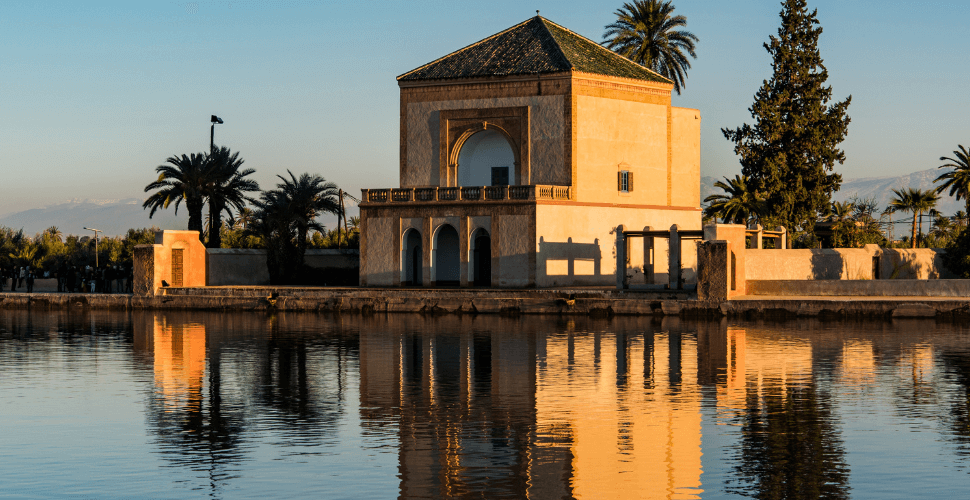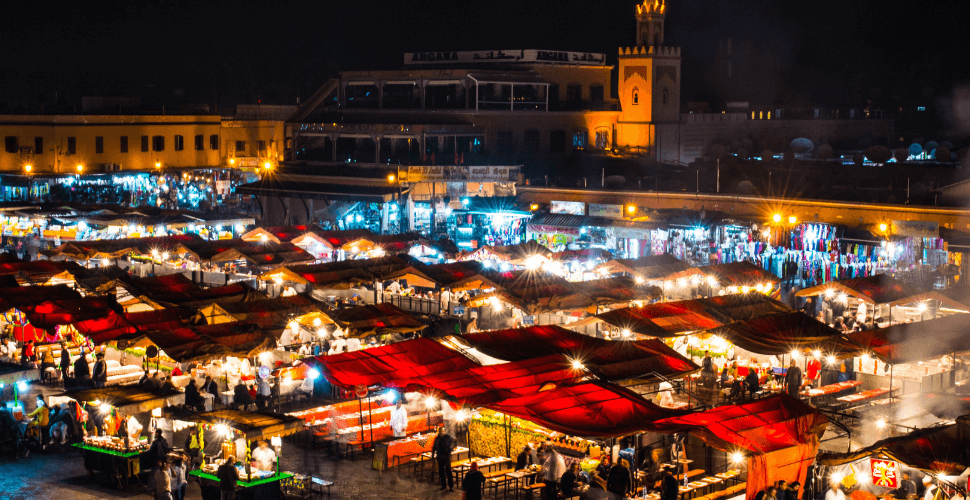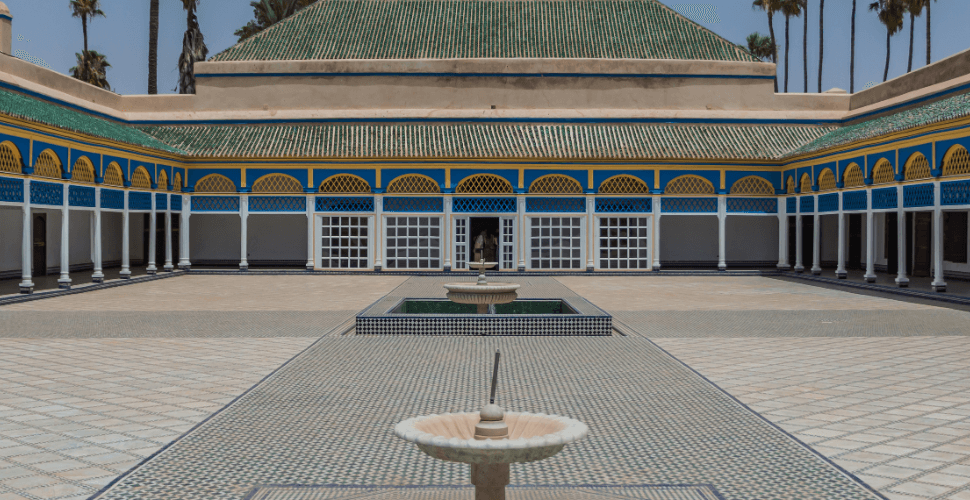Jacques Majorelle, a French painter, fell in love with the vibrant colors and unique flora of Morocco during a trip to Marrakech in 1917. In 1923, he purchased four acres of land on the outskirts of the city and began designing his own personal oasis. The garden was completed over several decades and became known as Jardin Majorelle.
Majorelle’s vision for the garden was inspired by both Islamic and Art Deco design elements. He incorporated bright blue walls, intricate tile work, and exotic plants from around the world into his creation. The garden quickly became a popular attraction among locals and tourists alike.
In 1980, fashion designer Yves Saint Laurent discovered Jardin Majorelle while visiting Marrakech. He fell in love with its beauty and decided to purchase it to ensure its preservation for future generations. Today, Jardin Majorelle is owned by the Fondation Pierre Bergé – Yves Saint Laurent and continues to be one of Morocco’s most beloved cultural landmarks.

The Vibrant Colors and Patterns of the Garden’s Design

The vibrant colors and patterns of Jardin Majorelle’s design are a feast for the eyes. The garden was designed by French artist Jacques Majorelle in the 1920s and 1930s, and he used bold, bright hues to create a unique atmosphere. The walls surrounding the garden are painted in a deep shade of blue that is now known as “Majorelle Blue,” which perfectly complements the lush greenery within.
As visitors wander through Jardin Majorelle, they will notice an array of intricate tile work throughout the space. From colorful mosaics covering entire walls to smaller details like flower-shaped tiles embedded into steps, these patterns add depth and texture to the garden’s design. Additionally, there are many hand-painted signs scattered around that provide information about different plants or areas within Jardin Majorelle.
One cannot discuss Jardin Majorelle’s design without mentioning its use of color blocking. This technique involves using large blocks of contrasting colors next to each other for maximum impact. For example, one area may have bright yellow flowers planted against a backdrop of rich purple foliage while another may feature red cacti standing out against white stones. These unexpected combinations make for an unforgettable visual experience at this stunning Moroccan oasis.
The Unique Flora and Fauna Found in Jardin Majorelle
Jardin Majorelle is home to a variety of unique flora and fauna that make it one of the most visited gardens in Morocco. The garden boasts over 300 species of plants from around the world, including cacti, bamboo, palms, and water lilies. Visitors can stroll through the pathways surrounded by lush greenery and vibrant flowers such as bougainvillea and hibiscus.
One of the most fascinating features of Jardin Majorelle is its collection of exotic birds. Peacocks roam freely throughout the garden displaying their colorful feathers while chirping birds perch on tree branches singing melodious tunes. It’s not uncommon for visitors to spot turtles sunbathing on rocks or darting across ponds filled with fish.
The conservation efforts put forth by Yves Saint Laurent Foundation have helped preserve this natural oasis for future generations to enjoy. In addition to maintaining the beauty of Jardin Majorelle, they also work towards protecting endangered species such as Moroccan tortoises that are found within its walls. Overall, a visit to Jardin Majorelle offers an opportunity to immerse oneself in nature’s beauty while experiencing Moroccan culture at its finest.

The Fascinating Relationship Between Jardin Majorelle and Yves Saint Laurent

Yves Saint Laurent first visited Jardin Majorelle in 1966 during a trip to Marrakech. He was instantly captivated by the garden’s vibrant colors and unique flora, which would go on to inspire many of his fashion designs. In 1980, Saint Laurent purchased the garden with his partner Pierre Bergé and began restoring it to its former glory.
Saint Laurent’s love for Jardin Majorelle is evident in his fashion collections, which often featured bold colors and patterns reminiscent of the garden’s design. The most famous example is perhaps Saint Laurent’s “Mondrian” dress from 1965, which was inspired by Dutch artist Piet Mondrian but also features hues found in Jardin Majorelle.
After Saint Laurent passed away in 2008, his ashes were scattered throughout the rose bushes at Jardin Majorelle as per his wishes. Today, visitors can see a memorial dedicated to him within the garden grounds. The relationship between Yves Saint Laurent and Jardin Majorelle continues to be celebrated through events such as exhibitions showcasing pieces from both worlds or fashion shows held within its walls.
The Artistic and Architectural Features of the Garden
The architecture of Jardin Majorelle is an exquisite blend of Moroccan and Art Deco styles. The garden was designed by the French artist Jacques Majorelle in the 1920s and 30s, who incorporated elements such as fountains, terraces, pergolas, and pavilions into its layout. One of the most striking features is the bright blue color used throughout the garden’s structures, known as ‘Majorelle Blue’, which creates a stunning contrast against the greenery.
The artistic touches found in Jardin Majorelle are also noteworthy. The garden is home to several sculptures created by various artists over time. Visitors can admire pieces such as “Le Silence”, a bronze statue by Charles Gabriel Sarrabezolles that depicts a woman holding her finger to her lips; or “La Grande Famille”, a ceramic work by Majorelle himself depicting a family of birds perched on branches.
Another impressive feature of Jardin Majorelle is its collection of Islamic art housed within its buildings. The villa on-site contains an extensive selection of artifacts from Morocco and beyond, including textiles, pottery, jewelry, and calligraphy. These works provide insight into Moroccan culture while adding another layer to the already rich aesthetic experience offered at Jardin Majorelle.

The Serenity and Tranquility of the Garden’s Atmosphere

The serene and tranquil atmosphere of Jardin Majorelle is one of the garden’s most captivating features. The peacefulness that permeates throughout the garden is a result of its carefully planned design, which includes winding paths, trickling fountains, and shaded alcoves.
Visitors can easily lose themselves in the tranquility of the garden as they stroll through its lush greenery. The sound of water flowing from various fountains creates a soothing ambiance that instantly relaxes visitors. The calming effect extends to the many benches scattered throughout the garden where visitors can sit and enjoy their surroundings.
Despite being located in bustling Marrakech, Jardin Majorelle offers an escape from city life with its serene atmosphere. It provides a sanctuary for those seeking respite from daily stresses or simply wanting to immerse themselves in nature’s beauty.
The Role of Jardin Majorelle in Moroccan Culture and Society
Jardin Majorelle plays an important role in Moroccan culture and society. The garden serves as a symbol of the country’s rich history, blending together elements of traditional Moroccan design with modern artistic influences. It has become a popular destination for locals and tourists alike, attracting visitors from all over the world who come to experience its unique beauty.
The garden’s creator, Jacques Majorelle, was deeply inspired by the vibrant colors and patterns found throughout Morocco. He spent years collecting rare plants from around the world to create his masterpiece, which is now considered one of the most beautiful gardens in North Africa. Today, Jardin Majorelle is not only a testament to his vision but also a celebration of Moroccan culture.
In addition to its aesthetic value, Jardin Majorelle also serves as an important cultural institution in Morocco. It houses several museums that showcase traditional Berber art and artifacts alongside contemporary works by local artists. Its connection with Yves Saint Laurent has helped bring attention to both Moroccan fashion and art on an international level. Overall, Jardin Majorelle continues to play a vital role in preserving and promoting Moroccan culture for generations to come.

Tips for Visiting Jardin Majorelle, Including Ticket Prices and Hours of Operation

When planning a visit to Jardin Majorelle, it is important to note that the garden is open every day of the week from 8 am to 5:30 pm. However, it is recommended to arrive early in the morning or later in the afternoon when there are fewer crowds and better lighting for photography. The entrance fee for adults is 70 Moroccan Dirhams (approximately $7 USD) and children under 12 years old can enter for free.
To fully enjoy your visit to Jardin Majorelle, wear comfortable shoes as there are many paths and stairs throughout the garden. It is also advisable to bring sunscreen, a hat, and plenty of water as temperatures can get quite hot during peak hours. Visitors should be respectful of their surroundings by not littering or damaging any plants or structures within the garden.
One final tip for visiting Jardin Majorelle is to take advantage of guided tours offered at an additional cost. These tours provide insight into the history and significance of various features within the garden, allowing visitors to gain a deeper appreciation for its beauty and cultural importance.
The Connection Between Jardin Majorelle and Moroccan Fashion
Jardin Majorelle has had a significant impact on Moroccan fashion. The vibrant colors and patterns found in the garden’s design have inspired many designers to incorporate these elements into their clothing collections. The bright blue hue known as “Majorelle Blue” is particularly popular in Moroccan fashion, named after the color of the garden’s iconic buildings.
Yves Saint Laurent was one designer who drew inspiration from Jardin Majorelle. He first visited the garden in 1966 and fell in love with its beauty and tranquility. In 1980, he purchased the property along with his partner Pierre Bergé, saving it from potential destruction due to development plans. Saint Laurent even had his ashes scattered in the rose garden at Jardin Majorelle following his death.
Today, Jardin Majorelle continues to influence Moroccan fashion through its ongoing connection with Yves Saint Laurent and other designers who draw inspiration from its unique aesthetic. It serves as a reminder of Morocco’s rich cultural heritage and inspires creativity within the world of art and design.

The Continuing Legacy of Jardin Majorelle and Its Significance to the World of Art and Design.

Jardin Majorelle’s legacy extends far beyond its physical boundaries. Its influence can be seen in the world of art and design, inspiring countless artists and designers to incorporate Moroccan motifs into their work. The garden’s vibrant colors and patterns, unique flora and fauna, and architectural features have all served as sources of inspiration for creatives around the globe.
One notable example is Yves Saint Laurent, who was so captivated by Jardin Majorelle that he purchased it in 1980 with his partner Pierre Bergé. The garden became a place of refuge for Saint Laurent, who often found solace among its tranquil surroundings. He even designed an entire collection inspired by the garden’s vibrant hues, which has since become iconic in the fashion world.
Today, Jardin Majorelle continues to inspire new generations of artists and designers. Its significance lies not only in its aesthetic beauty but also in its cultural importance as a symbol of Morocco’s rich history and heritage. As such, it remains an important landmark not just for tourists but also for locals who take pride in this national treasure that has gained worldwide recognition
Unleash the Adventure: Discover Our Excursions
Please note that every route listed on our website is simply a starting point. At our company, we believe in fully customizing every aspect of your trip to meet your specific timing, budget, and preferences. We offer complete flexibility to extend, adjust, shorten, add or even skip stops and towns within a reasonable frame.
Our team of experts will work with you to recommend the best routes and schedules that cater to your interests and create an efficient yet comfortable itinerary. Trust us to take care of all the details, so you can sit back, relax and enjoy your personalized travel experience.










